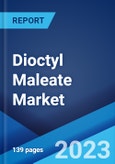The global dioctyl maleate market size reached US$ 279.7 Million in 2022. Looking forward, the publisher expects the market to reach US$ 339.7 Million by 2028, exhibiting a growth rate (CAGR) of 3.12% during 2023-2028.
Dioctyl maleate (DOM) is a clear, colorless liquid with an ester-like odor. It is widely used as a chemical intermediate and building block in several chemical production processes. For example, it is utilized in coating applications and the production of derivatives of succinic acid. It also finds application as a comonomer in vinyl and acrylic emulsion polymerization for paints and adhesives and a phthalate-free alternative to common phthalate-based plasticizers like dioctyl phthalate (DOP). Nowadays, it is copolymerized with monomers, such as styrene, vinyl acetate and acrylates, to provide elasticity and flexibility to the films.
Dioctyl maleate (DOM) is a clear, colorless liquid with an ester-like odor. It is widely used as a chemical intermediate and building block in several chemical production processes. For example, it is utilized in coating applications and the production of derivatives of succinic acid. It also finds application as a comonomer in vinyl and acrylic emulsion polymerization for paints and adhesives and a phthalate-free alternative to common phthalate-based plasticizers like dioctyl phthalate (DOP). Nowadays, it is copolymerized with monomers, such as styrene, vinyl acetate and acrylates, to provide elasticity and flexibility to the films.
Dioctyl Maleate Market Trends:
The escalating demand for convenient, packaged food products on account of rapid urbanization and busy schedules represents one of the key factors creating a positive outlook for the market. DOM is utilized in food packaging, paper plates, cutlery, and small appliances like roasters. Moreover, DOM acts as a plasticizer, emollient, and skin-conditioning agent in manufacturing personal care and cosmetics products, such as moisturizers, cleansers, makeup, shampoos, conditioners, and styling aids. Rising beauty consciousness among individuals, inflating per capita income and the growing influence of social media are influencing the demand for cosmetics worldwide. Apart from this, a shift towards waterproof and heat-resistant apparel and fabrics is catalyzing the demand for DOM to manufacture textile coatings for leather and sports clothing. In addition, the increasing participation of individuals in sports activities is contributing to market growth. Furthermore, the flourishing construction industry on account of rapid urbanization and the rising global population is influencing the demand for DOM positively to make adhesives, concrete, ceramic tiles, flooring underlayment, pre-finished panels, waterproofing, and roofing around the world.Key Market Segmentation:
The publisher provides an analysis of the key trends in each sub-segment of the global dioctyl maleate market report, along with forecasts at the global, regional and country level from 2023-2028. The report has categorized the market based on application and end user.Breakup by Application:
- Surfactants and Wetting Agents
- Adhesives
- Emulsion Paint
- Plasticizer
- Textile Coating
- Others
Breakup by End User:
- Chemical Industry
- Construction Industry
- Textile Industry
- Pharmaceutical Industry
- Food and Beverage Industry
- Others
Breakup by Region:
- North America
- United States
- Canada
- Asia-Pacific
- China
- Japan
- India
- South Korea
- Australia
- Indonesia
- Others
- Europe
- Germany
- France
- United Kingdom
- Italy
- Spain
- Russia
- Others
- Latin America
- Brazil
- Mexico
- Others
- Middle East and Africa
Competitive Landscape:
The competitive landscape of the industry has also been examined along with the profiles of the key players being Biesterfeld AG, Celanese Corporation, ESIM Chemicals, Hallstar Company, Hangzhou Qianyang Technology Co. Ltd., Henan GP Chemicals Co. Ltd., Merck KGaA, Nayakem Organics Pvt. Ltd., Polynt S.p.A., TCI Chemicals (India) Pvt. Ltd. and Yuanli Chemical Group Co. Ltd.Key Questions Answered in This Report:
- How has the global dioctyl maleate market performed so far and how will it perform in the coming years?
- What has been the impact of COVID-19 on the global dioctyl maleate market?
- What are the key regional markets?
- What is the breakup of the market based on the application?
- What is the breakup of the market based on the end user?
- What are the various stages in the value chain of the industry?
- What are the key driving factors and challenges in the industry?
- What is the structure of the global dioctyl maleate market and who are the key players?
- What is the degree of competition in the industry?
Table of Contents
1 Preface3 Executive Summary10 Value Chain Analysis12 Price Analysis
2 Scope and Methodology
4 Introduction
5 Global Dioctyl Maleate Market
6 Market Breakup by Application
7 Market Breakup by End User
8 Market Breakup by Region
9 SWOT Analysis
11 Porters Five Forces Analysis
13 Competitive Landscape
Companies Mentioned
- Biesterfeld AG
- Celanese Corporation
- ESIM Chemicals
- Hallstar Company
- Hangzhou Qianyang Technology Co. Ltd.
- Henan GP Chemicals Co. Ltd.
- Merck KGaA
- Nayakem Organics Pvt. Ltd.
- Polynt S.p.A.
- TCI Chemicals (India) Pvt. Ltd.
- Yuanli Chemical Group Co. Ltd.
Methodology

LOADING...
Table Information
| Report Attribute | Details |
|---|---|
| No. of Pages | 139 |
| Published | September 2023 |
| Forecast Period | 2022 - 2028 |
| Estimated Market Value ( USD | $ 279.7 Million |
| Forecasted Market Value ( USD | $ 339.7 Million |
| Compound Annual Growth Rate | 3.3% |
| Regions Covered | Global |
| No. of Companies Mentioned | 11 |








